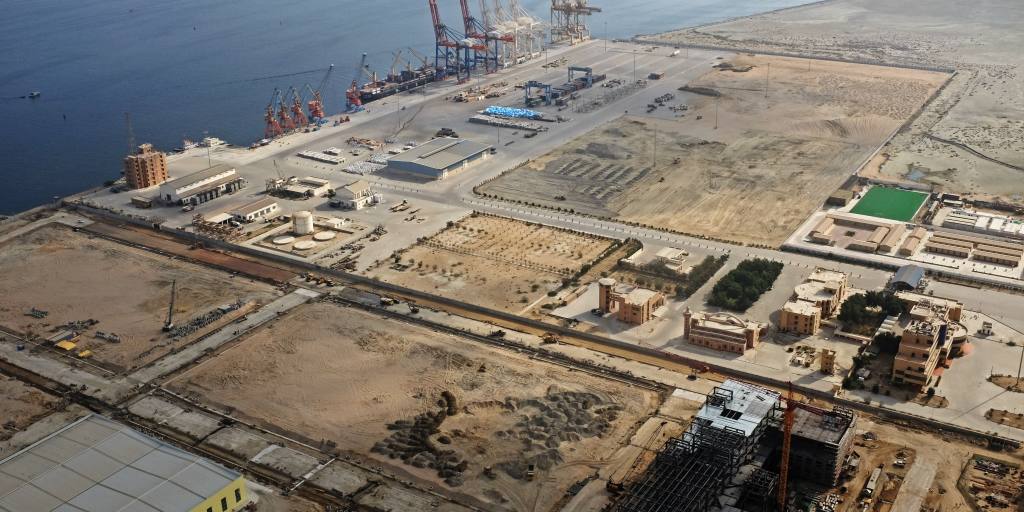Gwadar, Has an Objective The Size of Singapore
Islamabad: The Master Plan of the Smart Port City of Gwadar, in Pakistan, has inflamed economic experts due to the enormous amount of resources it will cost Pakistan with financial difficulties.
The port of Gwadar is an important part of the China-Pakistan Economic Corridor, or CPEC, which for China is an essential part of its Belt and Road initiative.
The master plan was approved at the ninth meeting of the CPEC Joint Cooperation Committee in November. It was developed by the Fourth Institute of Port Design at a cost of 521 million Pakistani rupees ($ 3.3 million). The FHDI is a Chinese engineering and design company.
The full text of the master plan has not been made public, and there is only limited information on the most prominent features on the website of the Gwadar Development Authority, the body responsible for implementing the plan. The project has been shrouded in mystery despite the demands of journalists and experts to launch it in its entirety.
Also Read: CDA to Start Construction of Sewage Treat Plant (STP)
“Why does everything related to CPEC have to be a mystery?” He asked an official who does not want to be appointed, who also said that it is “beyond understanding” why the government does not make public the data related to the project.
According to the limited information shared on the GDA website, the population of the city of Gwadar will increase to 2 million by 2050, the year the master plan ends, from 85,000 now. Under the plan, Gwadar Smart Port City will have seven ecological corridors, 11 urban functional areas and a special economic district to attract foreign capital. The planned development area is approximately 1,200 square kilometers.
Pakistani media have published reports on what life in the city would be like once the master plan is implemented. There have also been stories about an artificial island that will cost $ 10 billion to be built under the plan, but the GDA then contradicted these reports.
According to details published by The News, Gwadar’s per capita income will reach $ 15,000, almost ten times more than the national average now, and its economy will exceed $ 30 billion by 2050. In addition, Gwadar Smart Port City will become The country of Pakistan. third largest city and create 1.2 million jobs, according to the newspaper.
Shahzeb Khan Kakar, general manager of the GDA in a meeting with a group of builders called Gwadar the future “Singapore of Pakistan”.
Gwadar is across India from Singapore and is in a crucial place on the geopolitical map, along the eastern end of the Gulf of Oman. At the other end of the gulf is the Strait of Hormuz, a choke point through which 21% of world oil supplies travel.
Last week, the GDA lifted the ban on development activities in Gwadar in an attempt to promote development.
Experts are skeptical about how the governments of Pakistan and China can finance the project, which will require more than 100 billion Pakistani rupees just for basic infrastructure.
Katharine Adeney, professor and director of the Asian Research Institute at the University of Nottingham, believes that large levels of investment will be required. “This investment will have to be spent before international companies are persuaded to place their business there,” he told Nikkei Asian Review. “In the current economic climate, this can be controversial.”
Adeney was surprised that the plan no longer emphasizes renewable energy. “Pakistan faces a great challenge for climate change,” he said, “and building a city from scratch presents a unique opportunity to incorporate these technologies instead of relying on the power of coal.”
Gwadar locals interviewed by Nikkei say they are happy with the proposed developments, but are baffled about how they can be financed. Gwadar has been in the spotlight since 2002, when China began building the port. Eighteen years later and the city lacks basic infrastructure.
Currently, Gwadar depends on the irregular electricity of Iran (the city is about 80 km east of the Iranian border). A 300 megawatt coal-fired power plant planned under the CPEC is two years old. The city is also facing a water supply crisis, and some of its 85,000 citizens are skeptical that water can be supplied to the 2 million inhabitants planned in the future.
Mohan Malik, professor of strategic studies at the National Defense College of the United Arab Emirates, agrees with the idea that the Gwadar plan is too ambitious. The master plan, he said, “is not realistic unless and until the Chinese and Pakistani governments make Gwadar development their number one priority for the next two decades.”
Malik believes that, given the scarcity of resources and the fractured policy of Pakistan, not to mention China’s economic slowdown, especially after the coronavirus, it is very unlikely that Beijing and Islamabad can obtain the necessary resources for the master plan at any time in The near future.
The Gwadar megaproject is considered by some experts as a game changer, at least for the inhabitants of the city. Professor Adeney said the ambitious plan has the potential to provide much needed employment in Gwadar. She believes she can only succeed if the government guarantees that local communities benefit from employment opportunities.
Malik, however, is less optimistic. He said that the idea that Gwadar Smart Port City will overtake Dubai as a modern urban center and shopping center, across the Strait of Hormuz, looks like a cake in the sky. “It’s nothing,” he said, “but a great public relations exercise in the foreseeable future.”

